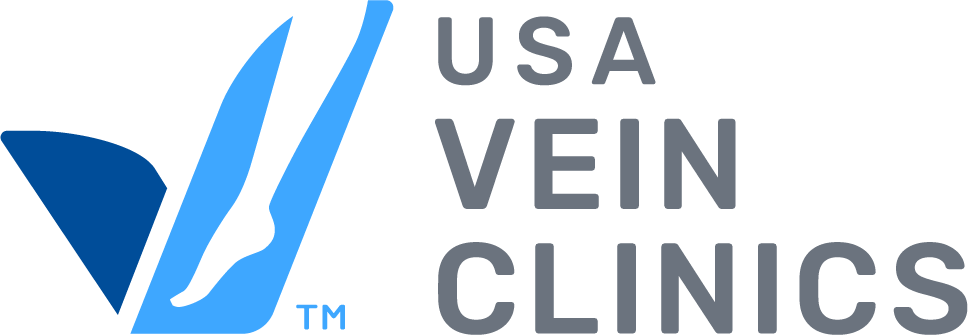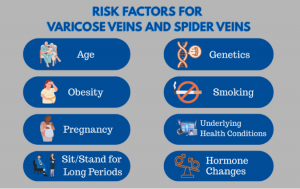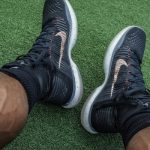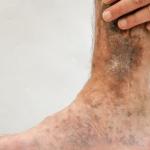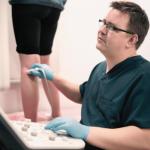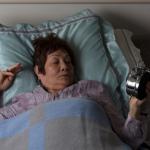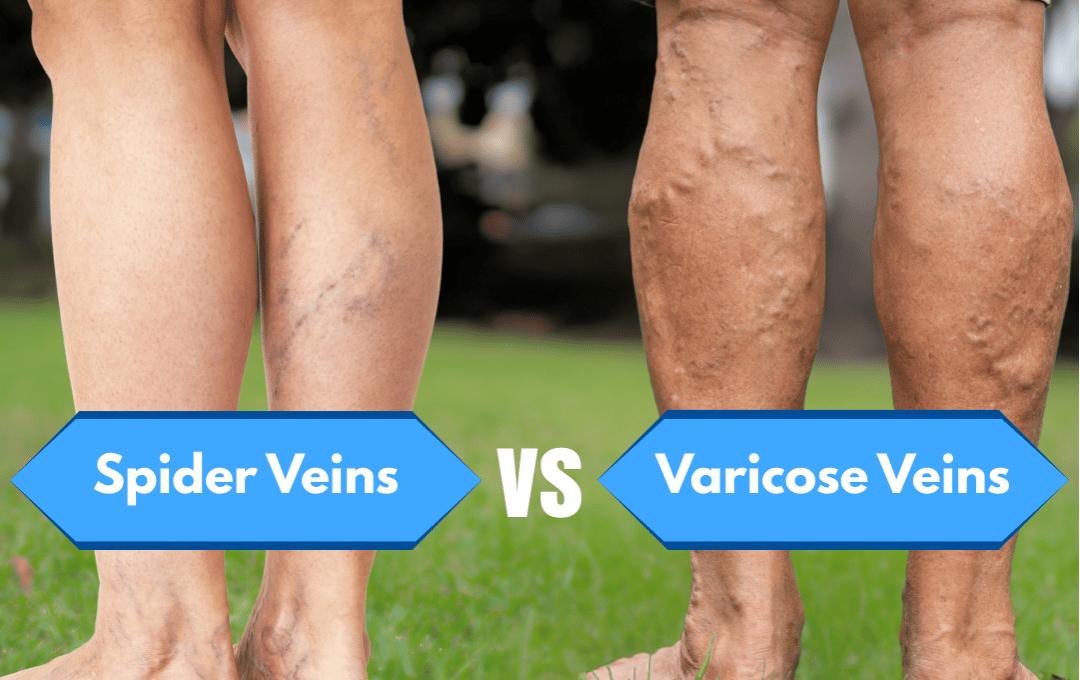
Have you ever noticed those tiny red lines on your legs or a swollen vein that bulges just beneath your skin? If so, you’re not alone, and are likely wondering what the difference is between these vein types, known as spider and varicose veins.
Spider veins are small, dilated blood vessels that typically appear on the legs and feet. Varicose veins, on the other hand, are enlarged and twisted veins that appear on the legs when the vein valves weaken, allowing blood to flow backward and pool in the veins.
While both spider veins and varicose veins are common, understanding their differences can help you easily distinguish between spider veins and varicose veins, including their causes, potential risk factors, and treatment options.
The Most Notable Difference Between Spider Veins and Varicose Veins
The most notable differences between spider veins vs. varicose veins are their appearance, size, and symptoms.
Spider veins appear as thin, web-like veins that develop just beneath the skin’s surface, typically measuring less than 1 millimeter (the thickness of a standard credit card) in diameter. Spider veins tend to be red, blue, or purple and are more common on the legs and face. Unlike varicose veins, spider veins are usually painless, though some individuals may experience mild itching or burning.
Varicose veins appear as swollen, twisted veins that bulge above the skin’s surface, typically measuring 3mm (three stacked credit cards ) or greater in diameter. Varicose veins can be blue or purple, most often appearing on the legs, ankles, and feet. They can cause more serious symptoms, including leg heaviness, aching, swelling, itching, or cramping—especially after long periods of standing or sitting.
Although both varicose veins and spider veins stem from faulty vein valves that cause blood to pool and increase pressure in the veins, varicose veins are more likely to progress and lead to more serious health complications without treatment.
That’s why consulting a vein specialist about any potential symptoms is so important when it comes to your health. Our symptoms checker can help you decide whether you need to make an appointment.
Is it Time to Get Your Symptoms Checked?
Do Spider Veins Turn Into Varicose Veins?
Both varicose veins and spider veins stem from similar health issues, but neither one causes the other. Most factors that escalate risk encompass anything that increases pressure in the veins or impairs the vein valve function.
Who’s at Risk? It Might Be More Common Than You Think
You might be surprised by who is more likely to develop spider or varicose veins. It’s often not a single cause, but a combination of life factors, such as:
- The “Age Factor”: Just like our joints and muscles, our veins naturally weaken over time, allowing blood to pool more easily.
- The “Hereditary Link”: Did members of your family, such as your parents or grandparents, have visible veins? If so, you are more likely to develop them.
- The “Daily Grind” Risk: Do you spend most of your day on your feet, like a nurse, a teacher, or a retail worker? Or are you sitting at a desk for hours? Both prolonged standing and sitting can disrupt healthy blood flow and increase pressure on the veins.
- The “Weight Issue”: Carrying extra weight puts additional strain on your circulatory system, making it more difficult for blood to return to the heart.
- The “Hormonal Rollercoaster”: Hormones play a huge role in vein health, especially for women. Changes during pregnancy, puberty, or menopause, or even from hormone therapy or birth control, can cause veins to relax and expand.
If you have any of these risk factors, our symptom quiz can help you check and see whether it’s time to consult a vein specialist.
Take our quick symptom quiz to check your vein health
First Stage Varicose Veins vs. Spider Veins
Although they may appear similar at first glance, there are plenty of differences between first-stage varicose veins vs. spider veins. Early varicose veins may appear flat or slightly raised at first and become more prominent or symptomatic over time. Spider veins tend to stay closer to the skin’s surface and remain small, while varicose veins may gradually enlarge, twist, or become more uncomfortable.
Why Spider and Varicose Veins Shouldn’t Be Ignored
While spider veins are often seen as a cosmetic issue, both spider and varicose veins can signal a more serious underlying condition known as vein disease, or chronic venous insufficiency (CVI). This condition occurs when veins struggle to push blood back to the heart, causing blood to pool and pressure to build.
Ignoring spider veins or varicose veins that are caused by vein disease can increase your risk of developing dangerous complications such as venous ulcers and blood clots. Venous ulcers are open, non-healing wounds that can become infected. In more advanced cases, a dangerous type of blood clot called deep vein thrombosis (DVT) may develop, which can lead to a life-threatening pulmonary embolism.
When to Seek Treatment for Spider Veins vs. Varicose Veins
Spider veins may indicate the early stages of vein disease if they appear suddenly or are paired with symptoms like aching or swelling. Varicose veins are more likely to worsen over time, leading to pain, leg fatigue, cramping, or even skin discoloration.
If you experience any symptoms or notice sudden changes in the appearance of your veins, consult a vein specialist at USA Vein Clinics. Our experts can provide a thorough evaluation to ensure an accurate diagnosis, allowing you to receive personalized treatment tailored to manage your symptoms.
Treatments for Varicose Veins and Spider Veins
If you’re dealing with spider veins or varicose veins, there are effective, minimally invasive treatment options that can help relieve symptoms, improve appearance, and reduce your risk of complications.
USA Vein Clinics offers office-based treatments that require little to no downtime and allow you to return to normal activities quickly. When you visit one of our nationwide clinics, a specialist will determine the most appropriate vein treatment for you.
Spider Vein Treatment
- Visual Sclerotherapy: A quick, in-office procedure where a chemical solution is injected into the spider veins, causing them to collapse and fade over time.
Varicose Vein Treatments
- Endovenous laser therapy (EVLT): A fiber is inserted into the vein and delivers laser energy to close it from the inside.
- Varithena® treatment: A non-surgical foam medication is injected into the vein to collapse and seal it.
- Ultrasound-guided sclerotherapy: An ultrasound helps find varicose veins hidden in the leg so that a vein specialist can precisely inject a sclerosant solution to irritate and close the vein.
- ClariVein® treatment: A catheter-based procedure using a rotating tip to deliver medication and close the affected vein.
- VenaSeal™ Closure System: A medical adhesive that seals the vein shut.
- Radiofrequency ablation (RFA): Thermal energy closes off diseased veins.
Once the affected veins are closed, blood naturally reroutes through healthier veins, improving their appearance while reducing symptoms and restoring blood flow. There’s no need for an overnight stay, so patients can return home the same day as their procedure.
Take Control of Your Vein Health Today
USA Vein Clinics is committed to helping patients through compassionate, patient-focused care. We are recognized by the Intersocietal Accreditation Commission for Vascular Testing (IAC), meaning we’ve met the gold standard in providing effective, evidence-based treatments for varicose and spider veins. With over 168 locations nationwide, we make it easier than ever to get expert care close to home.
Schedule an appointment online or call our toll-free number at 888.768.3467 to start your journey to better circulation.
FAQs About Spider Veins vs. Varicose Veins
Are Spider and Varicose Veins the Same?
Varicose and spider veins are not the same, but they can signal underlying vein issues. However, spider veins are more often a cosmetic concern, while varicose veins have a higher chance of developing into serious conditions like venous insufficiency.
Can you Prevent Spider and Varicose Veins from Developing?
While you can’t completely prevent spider and varicose veins, adopting healthy lifestyle habits, like regular exercise and a nutritious diet, can significantly reduce your risk and slow their progression before treatment.
Is it Safe to Exercise with Varicose Veins or Spider Veins?
Exercising with varicose or spider veins is generally safe and often beneficial, especially low-impact activities like walking or yoga. Regular movement strengthens the calf muscles, which help pump blood toward the heart and may temporarily alleviate symptoms of leg pain and swelling.
Do Compression Socks Help with Varicose and Spider Veins?
Compression socks can help alleviate varicose and spider veins by applying sufficient pressure to stimulate blood flow in the legs. This helps reduce leg pain and swelling, preventing the veins from worsening.
